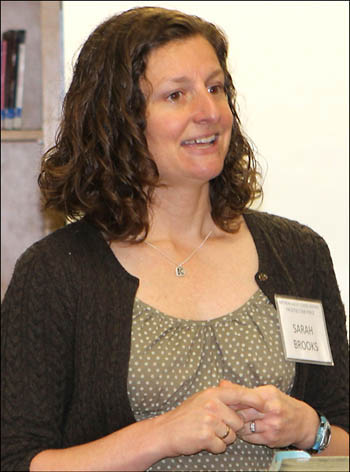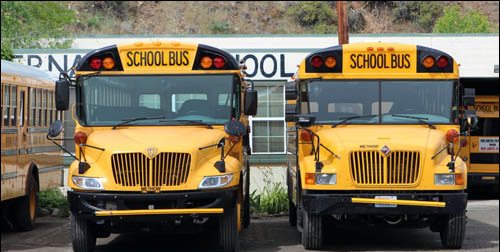home | internet service | web design | business directory | bulletin board | advertise | events calendar | contact | weather | cams

|
Look, Listen, Vote Methow Valley School District officials plan to ask voters in the November election to approve a property tax increase to pay for facilities renovation and maintenance and for updated technology equipment. Nothing new about that.  The Methow Valley School District needs six new school buses. The Methow Valley School District needs six new school buses.What’s new is how the district is deciding what to ask voters to pay for. In the past, half a dozen staff and district officials would prepare the information needed to place a levy or bond issue before voters. This time, it’s a more grass roots effort involving 20 people, including community members, students and staff. The district’s Facilities Task Force is co-chaired not by school officials but by Sarah and Erik Brooks, parents with a child attending school in the district. As part of their duties, task force members have led public tours of the facilities and held two open houses where voters could ask questions. “These facilities belong to the community. We need to maintain them,” Superintendent Tom Venable told Methow Grist. With that in mind, it seemed appropriate to ask community members to look at what’s needed and help decide what the highest funding priorities should be, he added. It’s the best way to get buy-in from voters, said Venable, adding that it was a strategy that worked well last year in the Bellingham School District, where he was employed before becoming superintendent in the Methow. After community members were enlisted to assess that district’s needs, voters there passed a $160 million bond issue, he said. “I’m using the same work plan.” On July 23, the school board is slated to decide how to pay for keeping the taxpayers’ school district assets in safe and proper working condition, and how to keep up with the ever-changing demands of technology. The board will decide whether to put a levy or bond before voters, according to Venable, who added that the dollar amount of the proposed tax increase request won’t be determined until the process has run its course, which will probably be the end of June.  Facilities Task Force co-chair Sarah Brooks explains the groups findings. Facilities Task Force co-chair Sarah Brooks explains the groups findings.The work of the task force is nearly complete, he said, and when its recommendations reach his desk, he will schedule another public meeting where voters can give feedback on the proposals before he asks the board to act on them. The funds will be used to address a variety of long-neglected facilities and equipment maintenance and replacement issues, according to school officials. They said some items pose safety concerns while others negatively impact student learning or are costing the 610-student district too much money. And it hasn’t been just community members who have toured the 110-acre campus to see for themselves what’s happening to their school facilities. Director Gary Marchbank said at the board’s April 23 meeting that he was surprised by “how many things they brought to our attention that I didn’t know about.” Who knew, for example, that, as Sarah Brooks explained, elementary school cafeteria tray counters “are too tall for short students to see what they’re getting when they go through the [food] line”? Or that gravel from the unpaved parking lots is being tracked into buildings and ruining floors? That doors used by physically disabled students aren’t compliant with the Americans With Disabilities Act? That some parts of the tennis courts are so broken down they may pose a hazard to players? That snow slides off roofs and onto the sidewalks student use? And then there are the big-ticket items: new school buses, and a more learning-friendly venue for students crammed into the Independent Learning Center adjoining the bus repair shop in Twisp. Not to mention the costs of continually updating technology and computers in a state that now requires all students to take state-mandated tests on line. The task force has wrestled with two challenges: prioritizing the district’s immediate funding needs and figuring out how to set up a longer-term funding mechanism to pay for future replacement and repairs. School directors indicated during recent board discussions that to keep facilities from deteriorating, they’d like to find a way to put the district’s long-term maintenance and replacement expenditures on a more stable and predictable footing. Director Frank Kline said his impression is that “We as a district have been afraid to face certain things because we didn’t have the money to pay for it.”  Independent Learning Center students attend classes in the building behind the school buses, next to the bus repair shop. Independent Learning Center students attend classes in the building behind the school buses, next to the bus repair shop.Among the themes that emerged as key issues during the task force’s fact-finding effort were safety, protecting assets, equity in learning opportunities for all students, preparing students for 21st Century employment and fiscal responsibility to taxpayers, Sarah Brooks said during the May 17 open house. She added that the “most prominent” issue that emerged from the process was replacing the school bus fleet. Transportation supervisor Hunter Maltais recommended to the board at its May 14 meeting that it purchase six new propane buses, plus three vans, two all-wheel drive vehicles, and one truck at a cost of $1 million. The propane buses would replace diesel buses that are beyond their intended life span and in some cases have been towed to Spokane for repairs. Propane fuel promises to be cheaper, Maltais told the board, and propane engines can be locally repaired. “We’ve been losing about $50,000 a year” trying to operate with the old diesel buses, he added. The state reimburses school districts for the cost of buses on a 13-year depreciation schedule, according to Maltais, who explained that the state recently changed its method of reimbursement to school districts. The upshot is that buying six buses at once will save the district money and get it “back into a steady stream” of state reimbursements, he said. Another major educational expense is the never-ending need to update rapidly changing computer technology. “The challenge for schools is how to accommodate this rate of change,” the district’s technology coordinator, Drew Simmons, told the board. Simmons stressed that an ongoing source of funding for technology upgrades is needed to keep up with the district’s technology needs. Computers are essential to learning and are in schools to stay, he indicated. “The state is requiring that all [student] assessments be done on line,” he told the board. Two previous technology levies in 2010 and 2012 were “start-ups,” Simmons added. “Now we need stability.” He recommended the board adopt a $1.3 million technology investment package that includes equipment upgrades for the district’s robotics engineering and 3-D printing courses, wireless system upgrades, plus replacement of 660 computers over a four-year period. In addition, he urged funding for software upgrades, maintenance and repairs, and staff support and training. 6/17/14 Comments
|